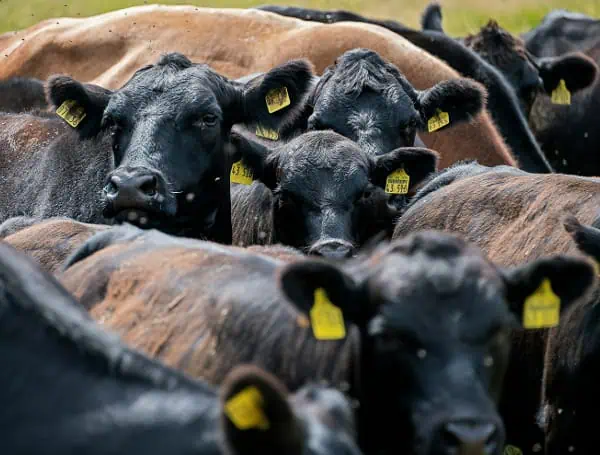A deepening crisis is unfolding along the U.S.-Mexico border as parasitic larvae from New World screwworm flies infest cattle in Mexico, prompting urgent action from U.S. officials to prevent a catastrophic spread into American agricultural lands. The infestation threatens to devastate the livestock industry, drive up beef prices, and inflict billions in economic losses if not contained.
The U.S. Department of Agriculture (USDA) has expressed concerns, twice reimposing a ban on live cattle, horse, and bison imports from Mexico since November 2024. This measure, while critical for containment, has left millions of dollars’ worth of cattle stranded south of the border, triggering alarm among ranchers and raising warnings of supply chain disruptions and escalating beef costs.
READ :DeSantis: California Rejected Florida Aid Amid Los Angeles Unrest, Citing ‘Inflammation’
The U.S. typically imports over a million cattle from Mexico annually, making a prolonged freeze a significant blow to supply.
New World screwworms, scientifically known as Cochliomyia hominivorax, are a parasitic fly whose maggots aggressively consume the living flesh of warm-blooded animals.
“Using an existing wound as a point of entry, they can burrow into a living animal with an existing open wound and cause serious, sometimes deadly, damage to the animal,” explained Andrew Short, chair of the UF/IFAS Department of Entomology and Nematology.
Animals can become infested through even minor wounds, such as a tick bite, a healing ear tag, or a recent brand. While livestock is particularly vulnerable, the screwworm can infest any warm-blooded mammal, including wildlife, pets, and, in rare instances, humans.
READ :Florida And Alabama Carry Out Executions On Same Day For Decades-Old Murders
Experts warn that an unchecked outbreak in the U.S. could lead to catastrophic economic consequences.
A Texas A&M AgriLife analysis estimates potential losses in Texas alone could reach billions, with conservative figures projecting $2.1 billion in the cattle sector and a staggering $9 billion in the hunting and wildlife sectors. Texas, the nation’s leading beef producer, would face increased labor and production costs, coupled with expensive veterinary treatments for affected animals.
Florida, with its warm climate and substantial animal populations, is considered particularly susceptible to the screwworm’s potential spread. The Florida Department of Agriculture and Consumer Services (FDACS) has issued an urgent alert, urging veterinarians, livestock producers, and animal health professionals across the state to be on high alert for signs of the New World screwworm.
The New World screwworm was eradicated from the U.S. in 1966, a feat achieved through the release of sterile flies. However, a stark reminder of its potential re-emergence occurred in 2016 when an infection spread through the Key deer population in the Florida Keys, eventually contained by the same sterile fly method.
Currently, a lab in Panama, the Panama-U.S. Commission for the Eradication and Prevention of the Cattle Borer Worm (COPEG), is producing millions of sterile flies weekly to combat the spread. The USDA has also pledged $21 million to renovate a production facility in Mexico to bolster these efforts. While the sterile fly technique proved effective in the 1960s, some experts, like Woodall, expressed concern that current production may not be enough to stem the tide.
READ: Florida Agriculture Gets Major Water Quality Boost: Simpson Announces BMP Manual Updates
Early detection is paramount in preventing a widespread outbreak. FDACS and University of Florida (UF) experts advise animal owners to watch for symptoms such as irritated behavior around a wound, head shaking, biting at an open wound, a distinct smell of tissue decay, the presence of maggots within a wound, a large red raised area on the skin, depression, loss of appetite, decreased milk production, and seclusion from the herd. Dr. Fiona Maunsell, a clinical associate professor at the UF College of Veterinary Medicine, stressed that infected wounds often become larger and deeper, accompanied by a foul odor and bloody discharge.
Immediate action is crucial if an infection is suspected. Animal and livestock owners must isolate the affected animal and contact their veterinarian or the State Veterinarian’s office without delay. Dr. Maunsell strongly advises against attempting to treat a maggot-infested wound without professional guidance, as this could hinder containment efforts.
Florida State Veterinarian Dr. Michael Short emphasized the importance of vigilance: “The earlier we catch a potential case, the better chance we have of containing it. We’re asking everyone who works with animals, whether in private practice or in the field, to take a second look at any wound that is unusual or doesn’t heal as expected.” Owners are also encouraged to keep wounds clean and covered, especially for animals spending significant time outdoors.
Please make a small donation to the Tampa Free Press to help sustain independent journalism. Your contribution enables us to continue delivering high-quality, local, and national news coverage.
Connect with us: Follow the Tampa Free Press on Facebook and Twitter for breaking news and updates.
Sign up: Subscribe to our free newsletter for a curated selection of top stories delivered straight to your inbox.

